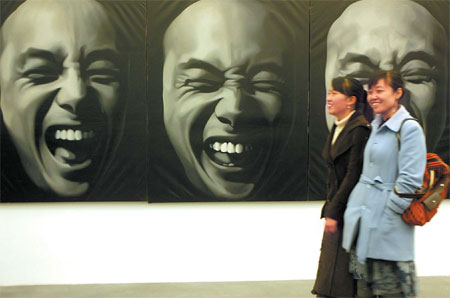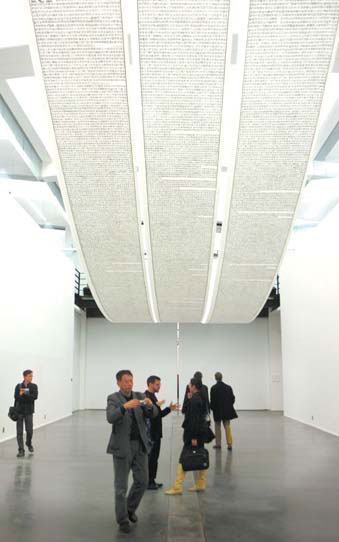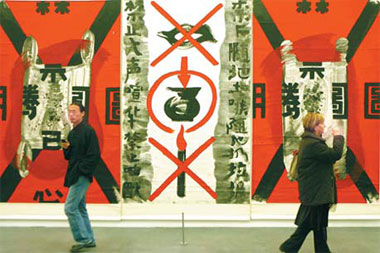Don't look back in anger
 |
|
Viewers pass by Geng Jianyi's The Second Situation on display at the Ullens Centre for Contemporary Art.Photos by Zhang Wei |
China's vanguard artists have been increasingly in demand since the new millennium began and now frequently show off their works at international biennales, art fairs and prestigious art museums.
Local and international investors have fueled the boom in Chinese art, and as a result, Western media outlets are taking note. There is the development of 798 Factory (now a tourist attraction), Dashanzi and Caochangdi in northeastern Beijing, and the emergence of numerous "artist villages" in suburban Beijing, particularly Songzhuang Township.
 |
| Xu Bing's Scrolls in the Sky is one of the heavyweight showpieces at the '85 New Wave exhibition at the newly opened Ullens Center for Contemporary Art in Beijing. |
Artists such as Zhang Xiaogang (painter of the series Bloodlines), Wang Guangyi (a "New Art Movement" leader) and "Cynical Realists" such as Fang Lijun and Yue Minjun have sold their works for staggering prices at auctions in Hong Kong, New York and London.
How did this happen?
Three retrospective shows in Beijing give art lovers a rare chance to discover for themselves the birth of China's contemporary art movement in the late 1970s and early 1980s.
"When looking back at the road Chinese contemporary art has taken, we should admit Stars Art Group is the progenitor," says Zhu Zhu, curator of a retrospective for the group.
Titled Origin Point, the exhibition showcases some 100 works by Stars Art Group members, including oil paintings, ink paintings, woodcuts and sculptures. Most of these works were featured in two pioneering Stars Art Group exhibitions, staged in 1979 and 1980.
The show will run from November 20-30 at the Today Art Museum in Beijing, then transfer to Nanjing.
"Every artist is a little star. Even the greatest artists are still little stars from a cosmic point of view. We called our group 'Stars' in order to emphasize our individuality. This was directed at the drab uniformity of the 'cultural revolution' (1966-76)," explains Ma Desheng, a key member of the Stars Art Group.
In the group's early days, experimental artists like Huang Rui, Ma Desheng, Yan Li, Wang Keping, Yang Yiping, Qu Leilei, Mao Lizi, Bo Yun, Zhong Acheng, Shao Fei, Li Shuang and Ai Weiwei, gathered for private discussion sessions and informal art shows.
They came to the attention of the public when they were denied an official exhibition at the China Art Gallery (now the National Art Museum of China) and responded by hanging their works on the park railings outside, on September 27, 1979. They also raised a banner with the words: "Kathe Kollwitz is our banner-bearer, Pablo Picasso is our pioneer."
 |
| Gu Wenda's collage-like ink painting Mythos of Lost Dynasties tackles the modern meaning of totems and taboos. |
The following day, police moved on the artists. The next day, September 29, the exhibition was denounced as illegal.
But this did not stop the group. On the contrary, they went even further and on October 1, the 30th anniversary of the founding of the People's Republic of China, the group's members organized a protest march calling for artistic freedom.
Finally, from November 23 to December 2, the Stars Art Group held its first proper exhibition at Huafang Studio, inside Beihai Park, Beijing.
At the beginning of the 1980s, Stars Art Group artists were not recognized by the Ministry of Culture, or the Chinese Artists Association. Therefore, that summer, they organized the "Stars Painters Society"- and registered with the Chinese Artists Association.
From August 24 to September 7, 1980, Jiang Feng, chairman of the Chinese Artists Association, allowed the group to exhibit for a second time, within the China Art Gallery, attracting around 200,000 visitors from Beijing and elsewhere.
The Stars Art Group exhibitions in 1979 and 1980 are widely regarded as the starting point for contemporary art in post-cultural revolution China. "The emergence of the art group mirrors the dramatic changes in China over three decades ago," curator Zhu says.
"The whole nation was to open up and reform. People were thirsty for knowledge and information from the outside world to empower themselves. This might explain why experimental art, music, poems and Western philosophies were extremely fashionable during that time. "
In Face Off: The Third Emancipation in Thinking in Contemporary China, published in 1998, People's Daily journalists Ma Licheng and Ling Zhijun described the impact of the Stars Art Group.
"The works are strongly influenced by modern, Western arts. This appears refreshing to visitors, used to political chaos but now looking forward to a peaceful and better future."
Another exhibition that looks at the early years of Chinese contemporary art is '85 New Wave, at the newly opened Ullens Center for Contemporary Art.
It "takes a step back from the commercial fray to examine a unique episode of art history when China began reinventing its own culture," curator Fei Dawei says.
The 1980s in China was a kind of reaction to the "cultural revolution" of the 1960s and 70s, Fei adds.
"Suppression of such a powerful culture could only be met with an equal and opposite force. The result of this explosive reaction was the '85 New Wave Movement."
Between 1985 and 1990, more than 1,000 young Chinese artists, living in an environment without galleries, museums, or systematic support for the arts, led a fundamentally influential artistic movement.
They broke with monolithic realism and were instead influenced by abstract art, post-impressionism and expressionism from the West. At the same time, however, they were inspired by traditional Chinese art forms such as ink painting and folk art.
In Fei's view, the '85 New Wave Movement opened a path for Chinese art to march toward internationalization. After 1985, contemporary art became the driving force behind Chinese art.
The movement also had its stars, artists who have made their names on local and world stages. The New Wave exhibition, runninguntil February 17, 2008, comprises 137 works from 30 of China's most prominent artists from the 1980s, including Wang Guangyi, Huang Yongping, Xu Bing, Zhang Peili and Gu Wenda.
Meanwhile, an exhibition chronicling another art movement in the 1980s, from Qingdao, East China's Shandong Province, is being held at the TS1 Museum for Contemporary Art, in Songzhuang Township, Beijing.
"While most people are casting their eyes on work from big names, I would like to remind them of the silent majority, largely ignored so far by art historians, the media and the art market," says Li Xianting, a veteran art critic and one of the participants in the 1985 New Wave Art Movement.
Li and curator Liang Kegang jointly prepared the exhibition which showcases more than 200 oil paintings, mixed media works, installations, old photos, posters and mimeographed art journals. The idea is to give viewers a clearer picture of what they are claiming is the biggest avant-garde art movement at a local level, from 1977 to early 1990s.
"In retrospect, it is like a dream. The exhibition draws me back to those years of passion and idealism," says Zhao Dewei, a key member of the Qingdao art group.
"We considered art something beautiful and noble. We began the movement without thinking of money or fame."
"At a time when money and fame are the catchwords of China's contemporary art world, an exhibition that re-examines the 1980s and the creative and free spirit of that era is timely," says Li Yuying, a participating female artist.
The exhibition Contemporary Art from the 1980s in Qingdao runs until January 31, 2008.
(China Daily 11/14/2007 page18)














